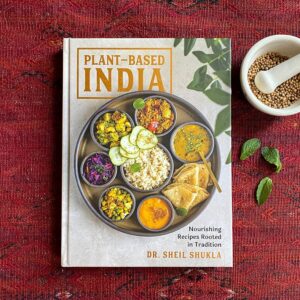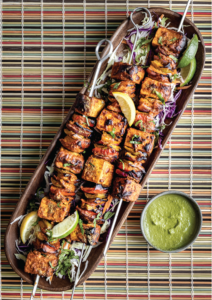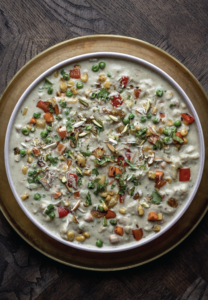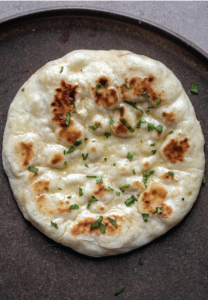 Diwali, the festival of lights, is the perfect time to embark on an Indian culinary tour. In Plant-Based India, Physician and Plant-Based Artist Dr. Sheil Shukla created 100 stunningly photographed vegan recipes that utilize fresh, healthy produce to capture the indelible flavors of India just in time to celebrate!
Diwali, the festival of lights, is the perfect time to embark on an Indian culinary tour. In Plant-Based India, Physician and Plant-Based Artist Dr. Sheil Shukla created 100 stunningly photographed vegan recipes that utilize fresh, healthy produce to capture the indelible flavors of India just in time to celebrate!
Start your perfect meal with Tofu Tikkā, followed by Navratan Korma served with nān bread.
 Tofu Tikkā
Tofu Tikkā
Serves 2 to 4 | Prep time: 12-24 hours | Cook time: 30 min
Tikkā is a northern Indian dish involving marinated protein or vegetables cooked in a tandoor, or clay oven. My version is made with marinated tofu baked on skewers in a conventional oven to mimic the traditional cooking vessel, which adds a char and smokiness to the dish. Using smoked paprika further pays tribute to the traditional cooking technique. Note that this recipe requires an overnight marinade to maximize flavor, so be sure to plan ahead!
Ingredients
- ⅔ cup (160 g) unsweetened plain nondairy yogurt
- 3 tablespoons tomato paste
- 6 garlic cloves, grated (about 1½ tablespoons)
- 1 tablespoon grated ginger
- 2 teaspoons fresh lime juice (about ¼ lime)
- 2 teaspoons garam masālā
- 1 teaspoon smoked paprika
- 1 teaspoon salt
- ½ teaspoon ground turmeric
- ½ teaspoon ground red chili
- ½ teaspoon black salt
- One 14-ounce (400 g) block extra-firm tofu, drained and pressed for 1 hour, cut into 1-inch (2.5 cm) cubes
- ½ medium red onion, cut into 1-inch (2.5 cm) chunks
- 1 to 2 bell peppers (any color), cut into 1-inch (2.5 cm) cubes
- A generous pinch of chāt masālā
- Roughly chopped cilantro or mint
- Lemon or lime wedges
Ingredient tip: Use a tofu press for best results, but if not available, you can place the tofu between two paper towels or clean kitchen towels. Place a flat plate or cutting board on top of the tofu and a few heavy cans (like beans or soup) on top of the plate.
Instructions
- In a large mixing bowl, whisk together the yogurt, tomato paste, garlic, ginger, lime juice, garam masālā, paprika, salt, turmeric, red chili, and black salt. Adjust seasoning to taste. The mixture should be pungent, spicy, and salty.
- Add the tofu, onion, and bell pepper to the mixing bowl and stir gently until each piece is well coated. Transfer to an airtight container and refrigerate overnight, or up to 24 hours.
- When ready to cook, preheat the oven to 450°F (230°C). Remove the mixture from the refrigerator and stir, then skewer onto 4 to 6 stainless-steel or bamboo skewers. If using bamboo skewers, they must first be soaked in water for 1 hour. Alternate the tofu, pepper, and onion on the skewers. Reserve any remaining marinade.
- Line the bottom of a 9 x 9 x 2-inch (23 x 23 x 5 cm) square baking dish with foil (for easier cleanup). Balance the skewers on top of the baking dish rims so the tofu is touching neither the bottom of the pan nor its neighbor.
- Bake the tofu skewers for 15 minutes, until starting to brown in spots. Remove from the oven, brush with the remaining marinade, rotate each skewer 180 degrees, then return to the oven for an additional 10 minutes, until browning in spots again. If desired, broil for a minute or two to obtain a char reminiscent of tandoor cooking.
- Remove from the oven and sprinkle with chāt masālā to taste and chopped cilantro. Serve hot with lemon wedges.
 Navratan Kormā
Navratan Kormā
Serves 4 | Prep time: 5 min | Cook time: 35 min
Navratan, or “nine gems,” refers to the nine ingredients—fruits, nuts, and vegetables—added to this rich, luxurious, and traditionally vegetarian gravy. It starts with a gravy made from onions, nuts, and other aromatics that are boiled until tender, lending a natural sweetness and white color to the final gravy. It proves that a little sweetness can work quite well in savory dishes. Broccoli, tofu, and chickpeas also work really well with this gravy. You can use fewer ingredients or substitute your favorites. Serve with plain rice or Nān.
Ingredients:
Gravy
- 1 yellow onion, roughly chopped (about 2 cups/300 g)
- ⅓ cup (50 g) raw cashews
- ¼ cup (36 g) raw almonds
- 1 tablespoon coriander seeds
- 1 tablespoon white poppy seeds, optional
- 1 bay leaf, optional
- 1 small piece mace, optional
- 4 green cardamom pods
- ½ teaspoon salt, plus more to taste
- 6 garlic cloves, minced (about 1½ tablespoons)
- 1 tablespoon minced ginger
- ½ green chili, minced, plus more to taste
Navratan
- 1 tablespoon olive oil
- ½ teaspoon cumin seeds
- ½ teaspoon fennel seeds, optional
- ½ red bell pepper, diced (½ cup/75 g)
- 2 cups (100 g) bite-size cauliflower florets
- 1 medium carrot, diced (½ cup/70 g)
- ⅓ cup (45 g) fresh or frozen corn
- ⅓ cup (45 g) frozen peas, thawed
- 1 tablespoon golden raisins
- ½ teaspoon garam masālā
- ⅓ cup (50 g) diced fresh or frozen pineapple, thawed
- Almonds, thinly sliced
- Pistachios, thinly sliced
- Cilantro, roughly chopped
Instructions
- For the gravy, combine the onion, cashews, almonds, coriander, poppy seeds (if using), bay leaf (if using), mace (if using), cardamom, and salt with 2 cups (480 ml) water in a large saucepan.
- Bring to a boil, reduce the heat to a simmer, and cook until the onions are very soft, about 15 minutes. Add the garlic, ginger, and green chili, and cook until fragrant, about 1 minute.
- Transfer the gravy mixture to a bowl or blender, cool slightly, remove the bay leaf, then blend until very smooth. Adjust the spiciness with more green chili to taste and blend again. Set aside.
- To prepare the navratan, heat the oil in a large, wide pan over medium-high heat. Add the cumin and fennel seeds (if using) and heat until they start to turn a deeper brown, about 1 minute.
- Add the bell pepper and sauté until it starts to soften, about 1 minute. Add the cauliflower, carrot, and a generous pinch of salt, and continue to sauté until they begin to brown, about 5 minutes.
- Add the corn and peas and sauté until they start to become tender, 5 minutes. Add water, 1 tablespoon at a time, or lower the heat if the vegetables begin to stick to the bottom of the pan.
- Stir in the gravy and raisins, reduce the heat to medium-low, cover, and simmer until all the veggies are tender, about 5 minutes.
- Add water as needed until desired consistency is reached. Stir in the garam masālā and adjust the salt to taste.
- Remove from the heat and top with the pineapple, almonds, pistachios, and cilantro.
 Nān
Nān
Makes 8 nān | Prep time: 1 hour and 15 min | Cook time: 40 min
Nān is easily the most widely known Indian bread in the West. Ironically, it’s rarely made in Indian households, and it’s generally enjoyed when eating out. This is because nān is cooked in a tandoor (clay oven), not in a home oven. Vegan nān is rarer to find since most nān are made with some form of dairy. This recipe is a wonderful alternative to the restaurant classic. Nān begins with a leavened dough made from all-purpose flour, its gluten content yielding perfectly fluffy yet chewy bread. Feel free to experiment with including whole wheat flour in different amounts for a more healthful version, starting with a 1:1 ratio of whole wheat to all-purpose. You can also infuse minced garlic (2 cloves) or ginger (1 teaspoon) into the dough while kneading, or infuse the vegan butter (if using) with herbs, such as mint or curry leaves.
Ingredients:
- 2 cups (250 g) all-purpose flour, plus more as needed
- 1 tablespoon cane sugar
- 2¼ teaspoons (7 g) active dry yeast
- ½ cup (120 g) unsweetened plain nondairy yogurt, warmed to room temperature
- ½ teaspoon salt
- 1 tablespoon vegan butter, melted, optional
- Freshly chopped cilantro, optional
- Put the all-purpose flour in a large bowl and set aside.
- In a small bowl, combine the sugar and yeast with ⅓ cup (80 ml) warm water and mix well with a spoon. Set aside until the yeast foams on top, about 10 minutes.
- Add the yeast mixture, yogurt, and salt to the flour. Stir together until well mixed. Knead the dough in the bowl, adding flour or water 1 tablespoon at a time as needed to form a smooth and soft dough, 2 to 3 minutes. (It will need less kneading than Western bread doughs do.)
- Place the dough in the large bowl, cover with a damp tea towel, and leave in a warm place (such as the oven with the oven light on) to rise until doubled in size, about 1 hour.
- Divide the dough into 8 equal pieces.
- Roll each piece out into a 6-inch (15 cm) circle (or oval), ⅛ to ¼ inch (6 to 13 mm) thick, dusting with flour as needed.
- Heat a medium nonstick or cast-iron skillet over medium-high heat. Place the nān in the skillet and cook until bubbles begin to form evenly and brown spots start to appear on the bottom, 2 to 3 minutes. Flip it over and cook until browned on the other side, 30 to 60 seconds. Alternatively, flip onto a grate placed over the flame to achieve charring characteristic of a tandoor.
- Brush the nān with butter, if desired, place onto a serving plate, and repeat with the remaining pieces.
- Serve the nān piping hot, cut in half or in quarters, if desired, and topped with freshly chopped cilantro (if using).
Enjoy your plant-based, authentic Indian celebration meal!


 Tofu Tikkā
Tofu Tikkā Navratan Kormā
Navratan Kormā Nān
Nān
